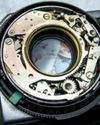How to effectively sharpen digital images.

IF YOU USE ANYTHING MORE CAPABLE than a smartphone for making photos, then you know all about sharpening.
Well, at least you can find a menu item that, in a fraction of a second, turns “acceptable” photos into snappier snaps. It’s like flush toilets: you may not understand exactly how they work, but you know how to use them.
Sharpening is routine today, and indeed many cameras do some automatic sharpening behind the scenes. That’s particularly true for phone cameras, because the manufacturers know most users aren’t going to download their efforts into Photoshop or something similar and beef up their imagery there.
But sharpening wasn’t always a routine operation. In film days, there wasn’t much you could do to improve the apparent detail of the photo. Once you clicked the shutter and registered the scene as a latent image in silver halide crystals, your picture was as sharp as it ever would be. All that happened afterwards only softened the shot. Chemical effects of the developer would bleed the edges of your subject matter, and imperfections in the enlarger would reduce sharpness even more. Like life after 40, it was all downhill.
هذه القصة مأخوذة من طبعة June 2017 من Shutterbug.
ابدأ النسخة التجريبية المجانية من Magzter GOLD لمدة 7 أيام للوصول إلى آلاف القصص المتميزة المنسقة وأكثر من 8500 مجلة وصحيفة.
بالفعل مشترك ? تسجيل الدخول
هذه القصة مأخوذة من طبعة June 2017 من Shutterbug.
ابدأ النسخة التجريبية المجانية من Magzter GOLD لمدة 7 أيام للوصول إلى آلاف القصص المتميزة المنسقة وأكثر من 8500 مجلة وصحيفة.
بالفعل مشترك? تسجيل الدخول

“The Pano Rocks!”
THIS ONE SURE DOES, AND FOR MORE REASONS THAN YOU MIGHT EXPECT

Landscapes In Motion
HOW MICHAEL SHAINBLUM CAPTURES HIS TRULY BREATHTAKING IMAGERY

Shooting Stars
PREPARED FOR A METEOR SHOWER, A PHOTOGRAPHER FINDS THE NIGHT HAS A FEW SURPRISES IN STORE.

Shake It Up
EXPLORE CREATIVE TECHNIQUES TO ADD VARIETY TO YOUR PHOTOS.

Life Lessons
HOW INSTAGRAM AND AN IPHONE TURNED A HOBBY INTO A SECOND CAREER

Shutter To Think
EVERYTHING YOU ALWAYS WANTED TO KNOW ABOUT CAMERA SHUTTERS BUT WERE AFRAID TO ASK

Monochrome Master
THE BLACK-AND-WHITE MAGIC OF MAX VADUKUL

True Grit
CAPTURING AMERICAN TRADITIONS IN TIMELESS BLACK-AND-WHITE IMAGES.

Treasure Chest
WHAT’S THE REAL ATTRACTION—THE PHONE’S CAMERA OR THE CREATIVITY OF ITS APPS?

Invisible Man
HOW DAVID INGRAHAM TAKES STREET PHOTOGRAPHY BEYOND TRADITION.